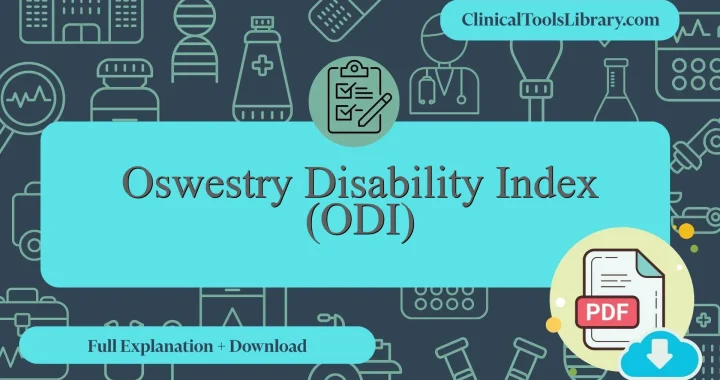In this article, we explain everything you need to know about the Oswestry Disability Index (ODI). We will cover the aspects it evaluates, the target population, a detailed step-by-step explanation, and how to interpret its results. Additionally, we will dive into the scientific evidence supporting this tool (diagnostic sensitivity and specificity) in clinical assessment. You will also find official and unofficial sources available for download in PDF format.
What does the Oswestry Disability Index (ODI) assess?
The Oswestry Disability Index (ODI) is a standardized questionnaire designed to assess the degree of disability and functional impairment in individuals with lower back pain. Its primary purpose is to quantify the impact of this condition on daily activities by evaluating limitations in areas such as pain intensity, personal care, lifting, walking, sitting, standing, sleeping, social life, traveling, and employment. The tool is widely recognized for its reliability and validity in both clinical and research settings. Healthcare professionals often utilize the Oswestry Disability Index score interpretation alongside the Oswestry Disability Index calculator to guide treatment decisions and monitor patient progress. A modified version, the Modified Oswestry Disability Index, is also available, offering enhanced specificity in certain populations, with resources such as the Modified Oswestry Disability Index PDF providing standardized formats for administration. The ODI remains integral in comparison to related instruments like the Neck Disability Index when assessing spinal-related disabilities.
For which type of patients or populations is the Oswestry Disability Index (ODI) intended?
The Oswestry Disability Index (ODI) is primarily indicated for patients with chronic low back pain and related lumbar spine disorders. It is widely utilized in both clinical and research settings to quantify the degree of disability and functional impairment. The ODI offers valuable insights when assessing treatment outcomes or guiding rehabilitation strategies in individuals experiencing mechanical low back pain, herniated discs, or degenerative spinal conditions. The tool’s reliability and validity support its use for monitoring longitudinal changes in disability levels, with the Modified Oswestry Disability Index version providing enhanced sensitivity in certain populations. The application of the Oswestry Disability Index calculator facilitates standardized score interpretation, enabling clinicians to objectively compare baseline and post-intervention disability statuses.
Step-by-Step Explanation of the Oswestry Disability Index (ODI)
The Oswestry Disability Index (ODI) consists of 10 items designed to evaluate the degree of disability related to low back pain. Each item addresses a specific aspect of daily living, including pain intensity, personal care, lifting, walking, sitting, standing, sleeping, social life, traveling, and employment/homemaking. The response format for each item uses a 6-point ordinal scale, ranging from 0 (no disability) to 5 (maximum disability), allowing patients to select the statement that best describes their condition. To administer the ODI, the clinician instructs the patient to read each section carefully and select one statement per item that most accurately reflects their current status. After completion, scores are summed and converted into a percentage, where higher values indicate greater disability. The instrument’s standardized structure ensures consistent assessment of functional impairment in patients with musculoskeletal disorders.
Oswestry Disability Index PDF Resources: Original, English Versions & Assessment Tools
Below are downloadable resources providing the Oswestry Disability Index PDF in both the original and English versions, designed to facilitate accurate assessment of patient disability related to spinal conditions. These documents support healthcare professionals in utilizing the Modified Oswestry Disability Index and complement tools such as the Oswestry Disability Index score Interpretation and Oswestry Disability Index calculator. The availability of these resources ensures reliable administration aligned with established standards of Oswestry Disability Index reliability and validity.
How to interpret the results of the Oswestry Disability Index (ODI)?
The Oswestry Disability Index (ODI) quantifies the degree of disability related to low back pain by calculating a percentage score derived from patient responses across ten sections, each scored from 0 to 5. The formula used is: ODI (%) = (Total Score / Maximum Possible Score) × 100, where the maximum score is 50. Interpretation follows established thresholds: 0-20% indicates minimal disability, 21-40% moderate disability, 41-60% severe disability, 61-80% crippled, and 81-100% reflects either a bed-bound state or exaggerated symptoms. For healthcare professionals, these results provide a standardized metric to assess functional impairment, monitor treatment efficacy, and guide clinical decision-making in rehabilitation planning, facilitating objective communication regarding patient progress and prognosis.
What scientific evidence supports the Oswestry Disability Index (ODI) ?
The Oswestry Disability Index (ODI) is a widely recognized tool developed in 1980 by Jeremy Fairbank and colleagues to quantify disability specifically related to low back pain. Extensive validation studies have demonstrated its strong reliability, internal consistency, and responsiveness across diverse patient populations suffering from lumbar spine disorders. Psychometric evaluations confirm that the ODI accurately reflects the impact of spinal conditions on functional ability and quality of life. Furthermore, comparisons with other disability measures have consistently supported its construct validity, while longitudinal research has underscored its sensitivity to clinical changes over time. This robust body of scientific evidence firmly establishes the ODI as a standard measure in both clinical practice and research settings addressing musculoskeletal disabilities.
Diagnostic Accuracy: Sensitivity and Specificity of the Oswestry Disability Index (ODI)
The Oswestry Disability Index (ODI) demonstrates variable sensitivity and specificity depending on the clinical context and cutoff values employed. Studies assessing its diagnostic accuracy for chronic low back pain report sensitivity ranging from approximately 70% to 85%, while specificity values commonly fall between 75% and 90%. The instrument’s ability to detect clinically meaningful changes in disability makes it a reliable tool in both research and practice, although thresholds may differ based on patient populations. It is important to interpret sensitivity and specificity metrics in conjunction with other clinical findings to optimize patient assessment and treatment planning.
Related Scales or Questionnaires
The Oswestry Disability Index (ODI) is frequently compared with the Roland-Morris Disability Questionnaire (RMDQ) and the Quebec Back Pain Disability Scale (QBPDS), which are also explained and available for download on ClinicalToolsLibrary.com. The RMDQ offers simplicity and sensitivity to change but may lack comprehensiveness compared to the ODI. The QBPDS provides detailed assessment of functional limitations but can be time-consuming to administer. Additionally, the Modified Oswestry Disability Index, with its refined scoring system, enhances reliability and is accessible as the Modified Oswestry Disability Index PDF on the same platform. The Neck Disability Index, although focused on cervical conditions, shares similar format and psychometric properties and is likewise described in detail on the website. Users can find tools such as the Oswestry Disability Index calculator and Oswestry Disability Index score Interpretation for standardized evaluation. While the ODI remains a gold standard due to its established reliability and validity, alternatives provide varied scopes and may suit different clinical scenarios involving chronic low back pain and related musculoskeletal disorders.



